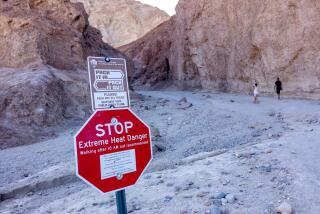Tokyo Swelters in ‘Heat Island’ Pressure Cooker
- Share via
TOKYO — It isn’t just the heat, or the humidity.
Tokyo has become so crowded that scientists say the accumulated heat from all the human activity is changing local weather patterns -- a sort of global warming but on the scale of a single city.
In Japan’s capital, morning fog has become a thing of the past. Evening thunderstorms, once a symbol of summer, are now more likely to come well after dark, or before dawn. Downpours are harder and more frequent. And calls for help are steadily rising.
“We are seeing more than just an increase in temperatures,” said Shuhei Akashi, head of the weather consultation department of Japan’s Central Meteorological Agency. “It is changing rain patterns and humidity as well.”
The warming of Tokyo, often to several degrees hotter than the surrounding countryside, is part of a phenomenon called “heat island” that scientists say is affecting the weather of cities throughout the globe -- from Toronto to Los Angeles to Shanghai.
Heat islands are the result of high concentrations of people.
The sheer number of their cars and air conditioners, which pump out hot air and greenhouse gases, lifts temperatures higher than the surrounding areas. Computers and other electrical devices in office buildings add more heat. Asphalt and concrete contribute because they absorb heat from the sun, while the lack of greenery means less shade and cooling water that can be evaporated into the air.
Tokyo is a showcase of how heat island can make its mark on a city.
Although last summer was relatively mild, Tokyo had a record 67 days in 2000 that hit 87 degrees or higher. Its population of about 12 million also sweated through 41 nights that year in which the temperatures exceeded 77 degrees. A decade earlier, there were only 23.
The nighttime figures are seen as particularly alarming. If the heat doesn’t let up much even at night, there is less relief for the sweltering masses and more demand for energy, which can create a vicious cycle.
“The nights are really unpleasant,” said Junko Nakajima, 26, an office worker who unlike most Tokyo residents prefers not to use air-conditioning. “Sometimes when it’s really bad, I put a cold, wet towel on my bed and sleep on that.”
The warming trend poses a significant health risk for the elderly, the very young, asthmatics and others vulnerable to sustained heat.
The number of ambulances sent to help people suffering from heat sickness rose from just over 100 in 1985 to 628 last year, according to statistics compiled by the Tokyo Fire Department. In 2000, 207 people in Tokyo died of heat-related causes, up from 152 in 1996, the Labor Ministry says.
This summer has been better. In early July, 15 people were given emergency treatment, about half the number treated at the same time last year. But that was when Tokyo was still officially in the rainy season.
In August, the city’s highs averaged just under 87, in line with its 30-year average.
The warming trend isn’t only felt in the summer.
According to the weather agency, the number of days when the Tokyo temperature dropped below freezing has fallen from an average of 53 a year in the 1930s to just three in 1990s.
And there are other, invisible dangers.
The combination of heat and sunlight can lead to an increase in ground-level ozone, which -- although beneficial when it is high in the stratosphere -- is a pollutant that can threaten health.
To fight the heat, Tokyo and other Japanese cities are encouraging builders to put rooftop gardens into the blueprints for major new projects. A proposal to bury cooling pipes under streets is also being considered.
More to Read
Sign up for Essential California
The most important California stories and recommendations in your inbox every morning.
You may occasionally receive promotional content from the Los Angeles Times.









